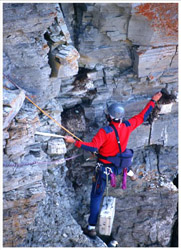Laboratories and research support: ecosystem health research laboratory
| Article Title |
|---|
Ecosystem Health Research Laboratory |
Located at the National Wildlife Research Centre, the new Ecosystem Health Research Laboratory will serve researchers working in the Ecosystem and Wildlife Health Division. The laboratory will help researchers conduct analyses that examine the effects of multiple stressors on wildlife and their habitats.

Research staff who study a variety of topics in the field of ecotoxicology will utilize the laboratory to examine how anthropogenic activities, alone and in combination, can negatively affect ecosystem health and function.
Samples are collected from the wild or, in the case of plants, grown indoors under controlled conditions in the Greenhouse and Growth Chambers at the National Wildlife Research Centre.
Current research and methodology
The Ecosystem Health Research Laboratory continues to expand its expertise to respond to new concerns, and many of the activities identified below that are not already underway are planned in the near future.

- Developing a suite of new standard guidelines and test methods for toxicity testing using plants, in association with activities being conducted in the Greenhouse and Growth Chambers
- Assessing biodiversity in agrarian systems using improved methodology (see also agriculture, land-use and ecosystems)
- Developing and validating new methods to measure stable isotopes and ecological tracers in wildlife to determine how ecosystem change affects food web structure, diet composition, and health of wildlife
- Developing methylmercury sensitivity thresholds in Arctic marine birds to expand on knowledge of the levels, trends and effects of contaminants on wildlife
- Developing methods to quantify pesticide exposure and the potential for direct and indirect pesticide effects in birds and mammals
- Developing standard guidelines and toxicity test methods for toxicity testing with native amphibians
- Developing methods to examine disease incidence and effects in native amphibians
Collaboration
Experts using the Ecosystem Health Research Laboratory work with many other researchers within Environment Canada, including those using the Greenhouse and Growth Chambers, Laboratory Services, and others at the National Wildlife Research Centre. In addition, wildlife researchers work closely with toxicologists at the Atlantic Laboratory for Environmental Testing and at the Pacific and Yukon Laboratory for Environmental Testing.

The Ecosystem Health Research Laboratory hosts collaborative investigations with students and academia, and users represent Canada on various international expert working groups associated with such organizations as the Organisation for Economic Co-Operation and Development, the European Food and Safety Authority, and the Arctic Monitoring and Assessment Programme of the Arctic Council.

Experts in laboratory
Further reading
- Contaminants and wildlife, Environment Canada
- Stable isotopes and ecological tracers, Environment Canada
- Agriculture, land-use and ecosystems, Environment Canada
- Metals toxicology, Environment Canada
- Outdoor study using native species shows how low concentrations of common pesticide turns male frogs into females, Wildlife and Landscape Science News, Environment Canada
- Monarch butterfly origins reveal migration mystery, Environment Canada
- Carpenter, D. and C. Boutin. Sublethal effects of herbicides on crops and wild plants: short-term effects compared to vegetative recovery and plant reproduction. Ecotoxicology (in press).
- Hebert, C.E., M.T. Arts, and D.V.C. Weseloh. 2006. Ecological tracers can quantify food web structure and change. Environmental Science and Technology 40: 5618-5623.
- Braune, B.M., M.L. Mallory, and H.G. Gilchrist. 2006. Elevated mercury levels in a declining population of ivory gulls in the Canadian Arctic. Mar. Pollut. Bull. 52: 969-987.
- Langlois, V.S., A.C. Carew, B.D. Pauli, M.G. Cooke and V.L. Trudeau. 2010. Low levels of the herbicide atrazine alter sex ratios and reduce metamorphic success in Rana pipiens tadpoles raised in outdoor mesocosms. Environmental Health Perspectives 118: 552-557.
- Girard, J., A. Baril, P. Mineau, and L. Fahrig. 2010. Carbon and nitrogen stable isotope ratios differ among invertebrates from field crops, forage crops, and non-cropped land uses. Ecoscience (in press).